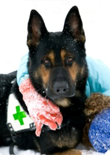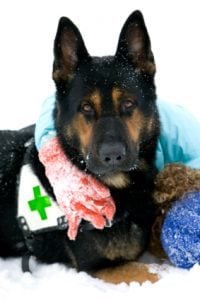Search And Rescue Dog Training
By Sally Gutteridge | Posts

 The Search and rescue dog team is an invaluable resource. Often working on a voluntary basis, handlers train their dog to find people that are lost, injured or at risk.
The Search and rescue dog team is an invaluable resource. Often working on a voluntary basis, handlers train their dog to find people that are lost, injured or at risk.
Employment
Search and rescue dog training teams are employed during natural disaster times all over the world to detect the whereabouts of injured or trapped people. Tirelessly working with their nose through tiny gaps in the rubble left behind from major earthquakes, detecting any human or animal trapped, search and rescue dogs and their handlers have saved many lives.
There are often search and rescue dog training teams on or in the immediate area of national parks and mountainous areas. Hikers can often lose their way during severe weather change and difficult walking conditions Dogs with their acute senses of both smell and hearing assist greatly in locating lost people on hillsides.
Police forces will employ dog teams to aid in the search for missing people. Parkland and urban woodland can be searched effectively by a dog and his keen senses. One Search dog team can do the work of many men.
Scent training
The Border collie is often employed as a search and rescue dog. A dog bred for rounding sheep and a busy, outdoor lifestyle. The stamina and hardiness of this breed of dog means it can, when fit and healthy work for long periods of time with little need for rest. When many lives depend on the dog’s performance the ability to do this is invaluable. Other effective search and rescue dogs are German and Belgian Shepherd’s, Labrador and golden retrievers.
The dog is working for the reward that he gets on finding the human, commonly known as the “body” in search and rescue dog training circles. The reward can be a toy or food and the training will need to be built up so that the dog has the stamina to search for a long time, sometimes many hours.
Search and rescue dog training will focus on scent. Dogs are trained to detect the scent of a human being and lead their handler to it. Scent training is a great experience for the dog and his handler.
A lost person in extreme weather conditions will naturally attempt to crawl into a space and keep warm. If lost for a long time the person can lose consciousness and develop hypothermia. When unconscious the person cannot draw attention to himself so the search dog training team’s efficiency to locate a scent is a vital addition to search.
When a human being is out in a rural area he will create something called a scent pool. The natural scent of a person consists of bodily odors, clothing and disturbance of the area such as crushed vegetation. The scent pool will either accumulate in a rough circle around the human or create a cone like area of scent dependent on wind, other weather and environmental conditions. Search and rescue dog training focuses on the dog detecting this scent and finding its source.
Indication and follow up
On recognizing a scent, the dog’s behavior will change. This exact change will depend on the individual dog, some dogs check pace back into the scent and others become busier with movement. Every search and rescue dog handler will recognize his dog’s indication of scent and know to encourage follow up of this sign. Indication is one of the most important factors of search and rescue dog training.
Volunteering
Search and rescue dog training teams often work together in groups on day or weekend long events to work their search dogs. Volunteers without a dog can join them to act as the “body”. This is an important role which can vary between encouragement for new dogs in training and progress to many hours hiding in the hillside, often with a book and sleeping bag. By hiding and offering a reward to the dog when he locates them these volunteers are helping to build the foundation of effective trained dogs. Volunteering as a “body” for search and rescue dog training is a rewarding and worthwhile experience. This type of volunteering is great fun and extremely social.
Session expired
Please log in again. The login page will open in a new tab. After logging in you can close it and return to this page.